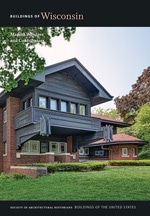
Isaac Witter, a banker, and George Mead, who managed the Consolidated Power and Paper Company, the city’s leading industry, built this Gothic Revival block as a commercial real estate venture, replacing a long row of eleven buildings, some of which dated to the 1890s. The two-story structure spans a full city block, and a nearly continuous row of windows amplifies its horizontality. Breaking the horizontal line, the block is divided into eleven bays with a shop in each, and the bays are further divided by pronounced mullions, which rise above the cornice as finials. Between the mullions, trios of lancet arches embellish the recessed frieze panels. Gothic-arched entrances near each end of the building give access to the second story. The principal entrance occupies the central bay, which rises several feet above the roofline and terminates in elaborate finials. A broad elliptical arch spans the entrance, embracing a multipaned clerestory. The building’s glazed terra-cotta walls survive, although the windows and storefronts have been altered.

